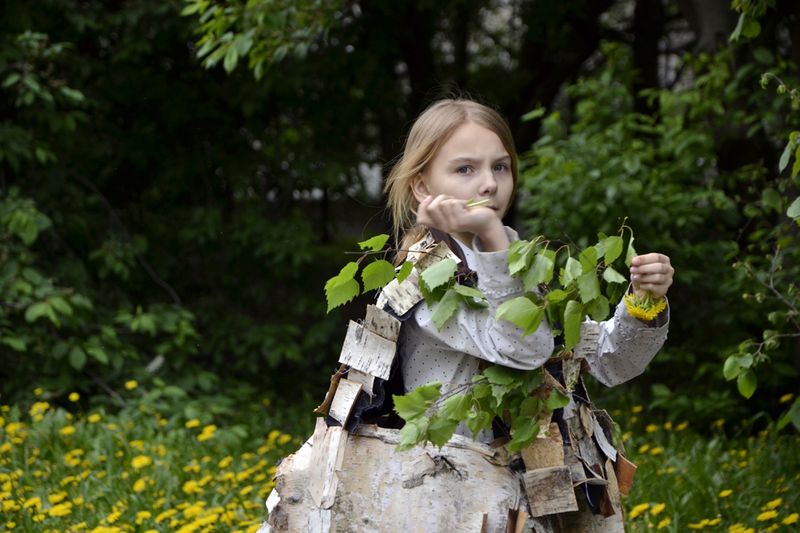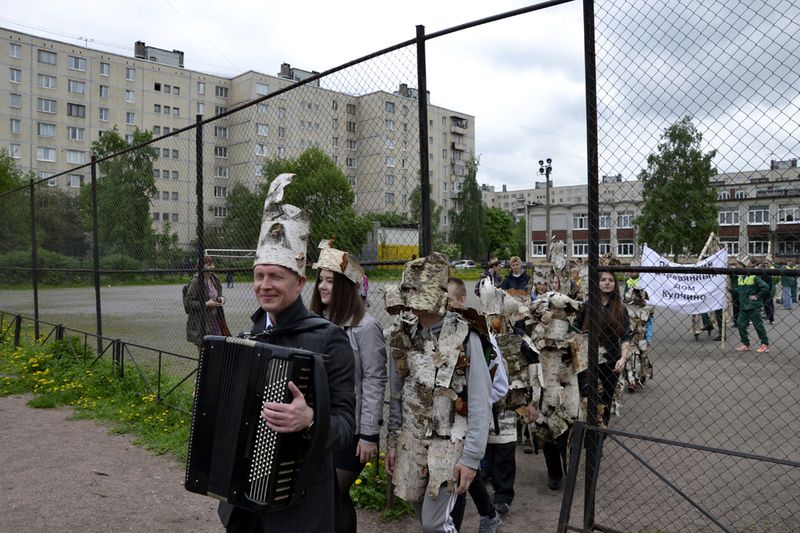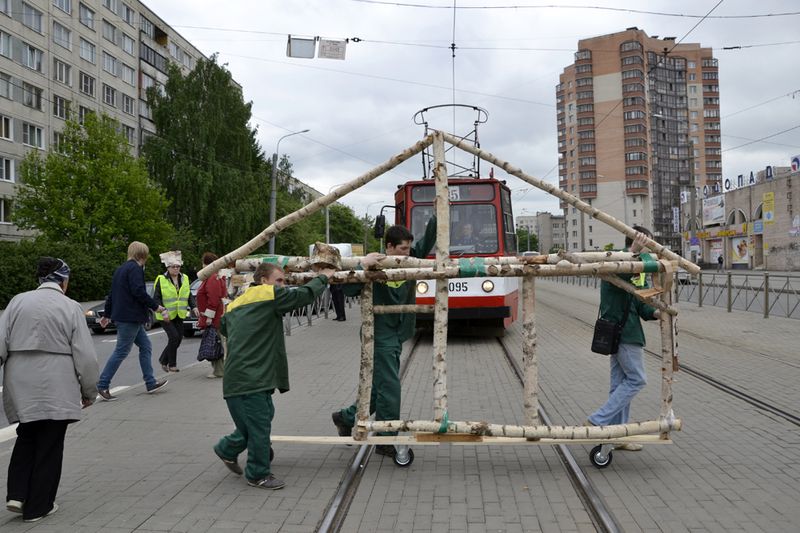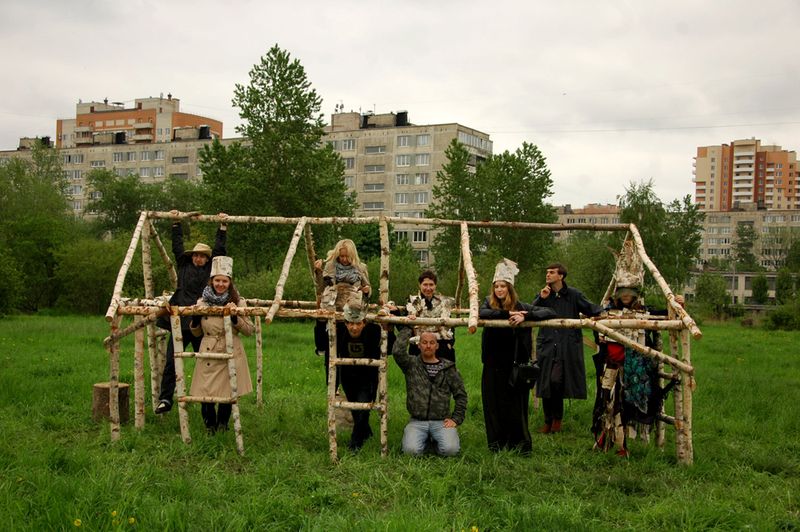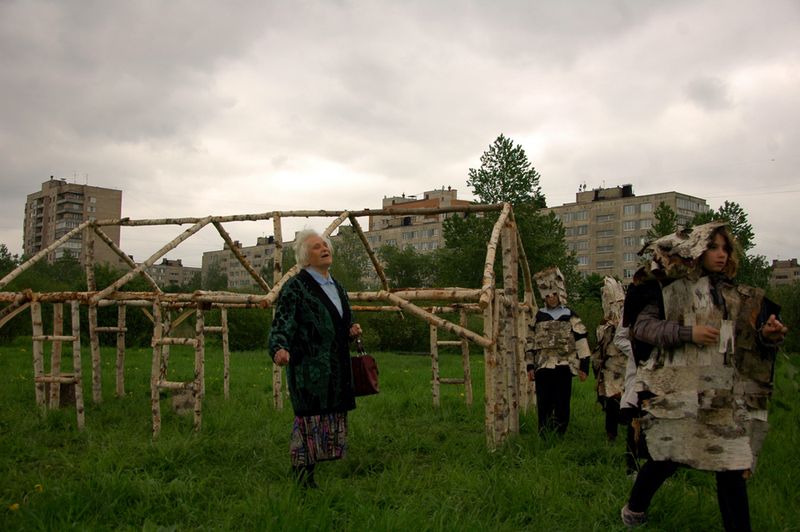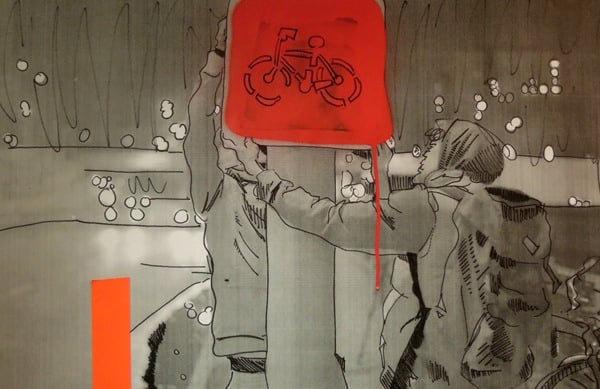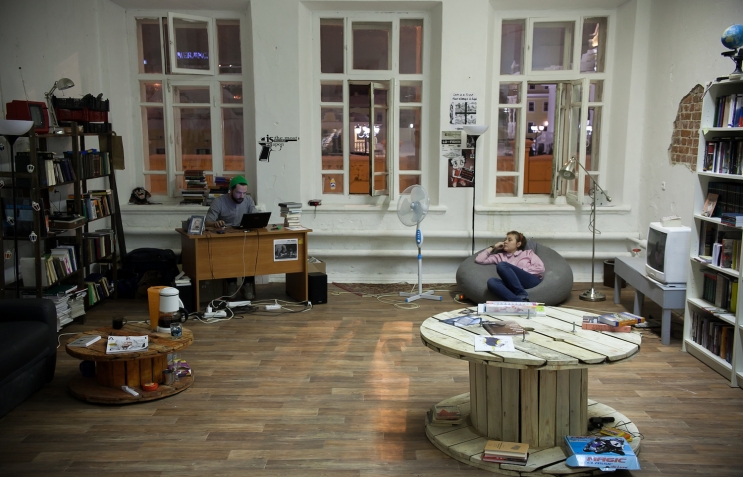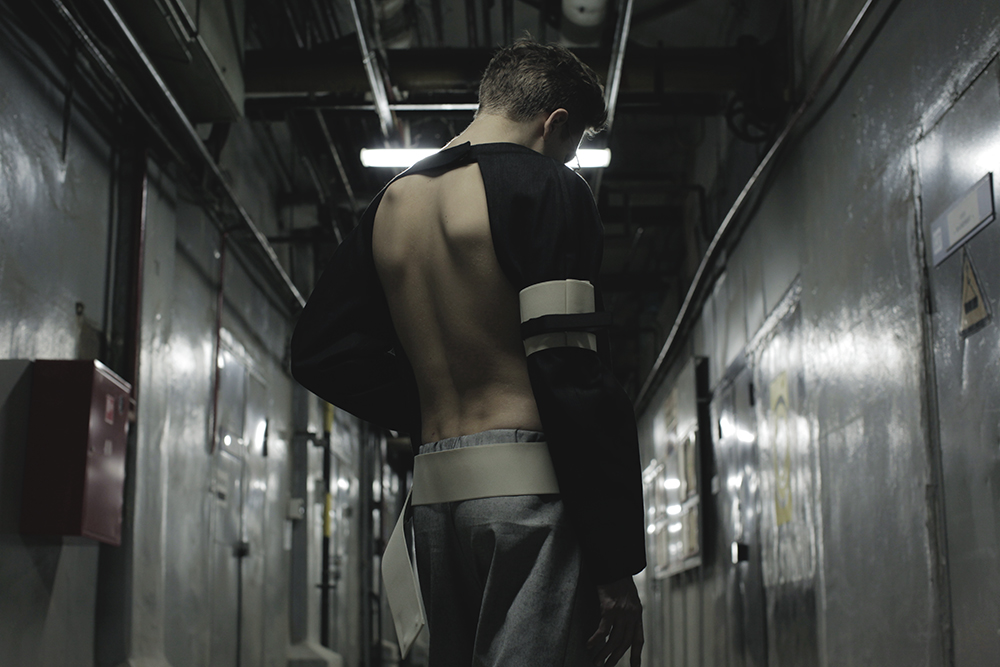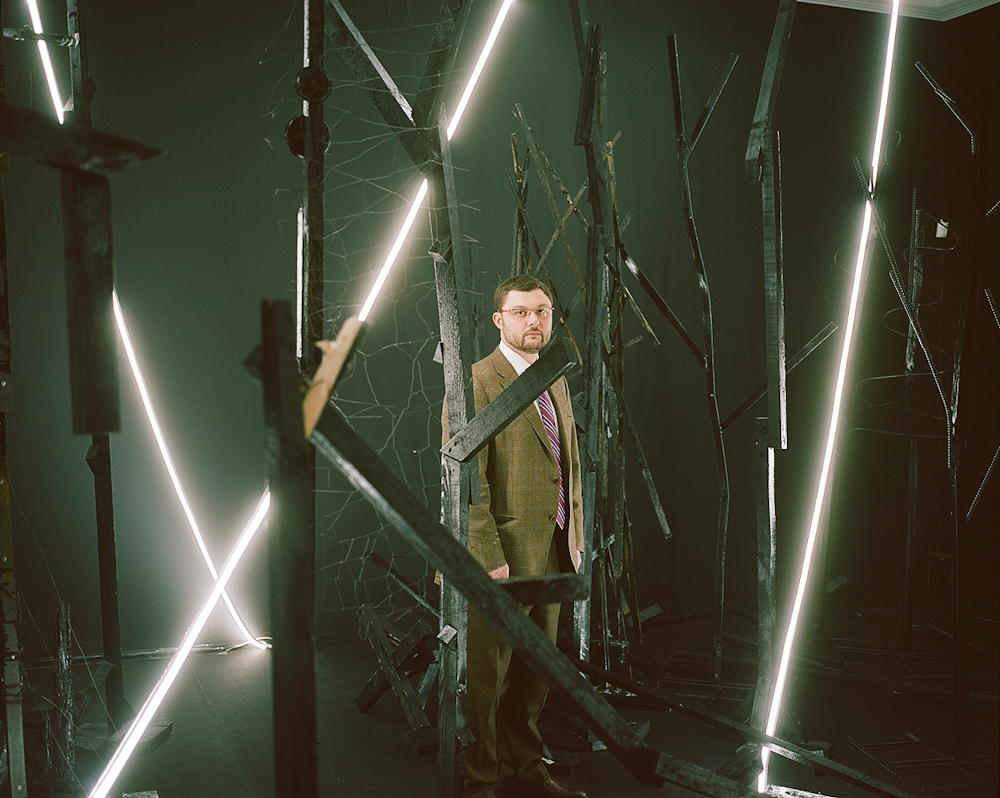Going public: suburbanites become situationists in St Petersburg art project Critical Mass
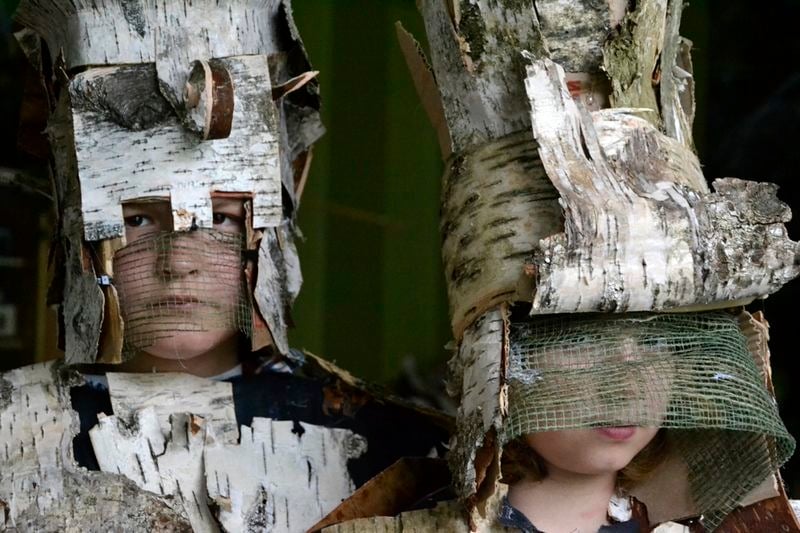
Public engagement in contemporary art is trendy, but often lightweight and quickly forgotten. St Petersburg's Critical Mass, argues Sasha Galitzine, takes a different approach, engaging suburban communities and reinvigorating local mythology
It’s not what you expect among the monotonous tower blocks of Kupchino, a grim St Petersburg suburb. Passers-by look on with a blend of ambivalence, amusement and incredulity. To the joyful tunes of the bayan (a Russian accordion), a throng of children clad in birch bark march slowly forward — a walking forest. Behind them, older boys proudly wheel along sections of a half-scale birch-wood house frame and hold aloft a banner: “The last wooden house in Kupchino”.
This astonishing scene, seemingly so Russian, is actually the work of an Irish artist, Gareth Kennedy, who masterminded this “folk-fiction” procession as part of Critical Mass, an international public art project that investigates city life in St Petersburg. Founded in 2011 by curator Anna Bitkina and sociologist Maria Veits as part of their wider project, the Creative Association of Curators (TOK), Critical Mass represents a thoughtful, interdisciplinary twist on public art — a genre that can often become banal or inconsequential.
“We want to engage as many people as possible”
Participatory art projects are increasingly popular around the world, not least because their social agenda can attract considerable sponsorship. However, these projects are also often criticised for failing to achieve results. Bitkina and Veits, who had to look abroad for funding, even though their work is almost unprecedented in Russia, do not make unrealistic claims about grandiose changes. Their aim is to make small, lasting changes for the people who interact with the work. “We don’t want to shock and intersect with public space in an aggressive way,” says Bitkina. “We want to engage as many people as possible.” They deliberately involve the police and city administration, striving gradually to “enlighten them and change their ways, to show them that things can be done in a certain way”.
The process begins with Veits consulting with other sociologists, anthropologists, historians and residents to locate stories and problems in the area; then Bitkina commissions and curates artists (eight this year) to respond to these problems in public spaces. “The last wooden house in Kupchino” is typical of Critical Mass in its attempt to engage with communities that are normally cut off from both the art world and from discussions about development, and in its focus on neighbourhood and belonging.
“She even gave her daughter a flare to fire at the authorities”
The march comes to an end in a meadow, where the volunteers sip birch juice and start assembling the wooden house. They are joined by the guests of honour: Iraida Vasiliyeva and her family. Vasiliyeva tells everyone the story of her mother, Alexandra Nydskova, who lived in the last wooden house in the old village of Kupchino and who refused to move when the council assigned her a new apartment. She sat in her own house in protest for five years, even though she was already in her eighties and the council had cut off her water and electricity and removed all her furniture. Nevertheless, despite a groundswell of community support, on 6 March 1976 Nydskova was dragged out to watch as her house was destroyed. Now every year Vasiliyeva and her family come to the site to remember her story. This year she told the assembled crowd how her mother had given her a flare to fire at the authorities if they came to evict her: she never used it, but always kept it.
Kennedy, whom Bitkina met when he represented Ireland at the Venice Biennale in 2009, puts emphasis on the way that being creative can reconnect people. For his Critical Mass work he conducted workshops with local Kupchino schools — one school made the birch-bark costumes and another used foraged timber for the house-frame — Kennedy reinvests the students with pride in their home-made production and combats the passivity of modern lives in which everything is shop-bought and China is “the workshop of the world”.
Critical Mass belongs to a long tradition of artists’ social engagement as a response to alienation from production and from the community. One thinks particularly of the Situationist International (1957-1972), and the argument of its founder member Guy Debord in Society of the Spectacle (1967) that everyday life had become so commoditised “that social relations are no longer authentic”. In response SI created participatory actions involving all classes in order to find a greater sense of community against the background of an increasingly privatised capitalist state. Their mission was, of course, partly inspired by earlier radical performance artists like the Dadaists in the 1910s and 1920s, who themselves drew on some of the theories and practices of the Russian avant-garde.
Kennedy’s work stands out from this lineage because of its emphasis on myth and tradition. His folk-fictions seek to create new traditions that will represent the community and provide them with common touchstones of identity. He is guided by Claude Levi-Strauss’s belief that the myth must be enacted to find new relevance in the contemporary, and by the notion of “shared anthropology” pioneered by filmmaker Jean Rouch, whose documentary films made North African communities act out their daily lives with “critical awareness”. “Myth,” says Kennedy, “becomes something that is embodied and manifested, in this case in public and civic space through the aesthetic form of the procession.” In the Kupchino action the artist takes an intimate, personal tradition — the story of one family — and turns it into a shared myth for the whole community by re-enacting it in a public space with 60 participants, and then by showing them his Super-8 recording of the event.
“Until recently the Russian language had no single word for ‘privacy’”
The dissolution of communities is a global problem, but it is felt particularly acutely in Russia today. Although the peasant commune is an idea that has been manipulated from above for centuries — first by nineteenth-century Slavophiles, then by the Communists — there is no doubt Russian peasant life was more oriented around communality living than that of their western counterparts. (It is often noted that until recently the Russian language had no single word for “privacy” or “self”.) This allegedly ego-free existence was subsequently seen as a means by which Russia might change the world — an idea that entered easily into the discourse of the Soviet state, despite the fact that collectivisation, industrialisation and urbanisation effectively destroyed the peasant commune. Instead, a different type of shared living was forced on people: the cramped communal flat. The Bolsheviks had, in the words of Walter Benjamin, “abolished private life”.
In the 1950s Khrushchev launched a new wave of building to alleviate the terrible conditions in the kommunalki, but the low build-quality of these developments remains a problem. Likewise, the final end of the forced community of the shared flat after the collapse of Communism may have been a relief, but the subsequent wholesale polarisation of society and the privatisation of the nation’s wealth have severely exacerbated the poverty divide.
It is fitting, therefore, both that the last wooden house in Kupchino was the final fragment of an old peasant commune, and that it is surrounded by Khrushchev-era tower blocks. Kennedy’s work treats this site as the symbolic heart of the community, suggesting an attempt to rebuild the house symbolically and thus to renew the societal bonds that this lost community was thought to embody.
But the greatest sense of public gratification came from one of the unscripted moments that occur naturally when the artist-viewer hierarchy is broken in public art. Just as Kennedy and Vasiliyeva shook hands and posed for photos by the handmade wooden house, a brightly coloured rocket exploded in the sky above them. It was the flare her mother had given her back in 1976. Vasiliyeva’s brother had decided to fire it today — clear confirmation of the significance and resonance of this social project for the family and for all of Kupchino.
